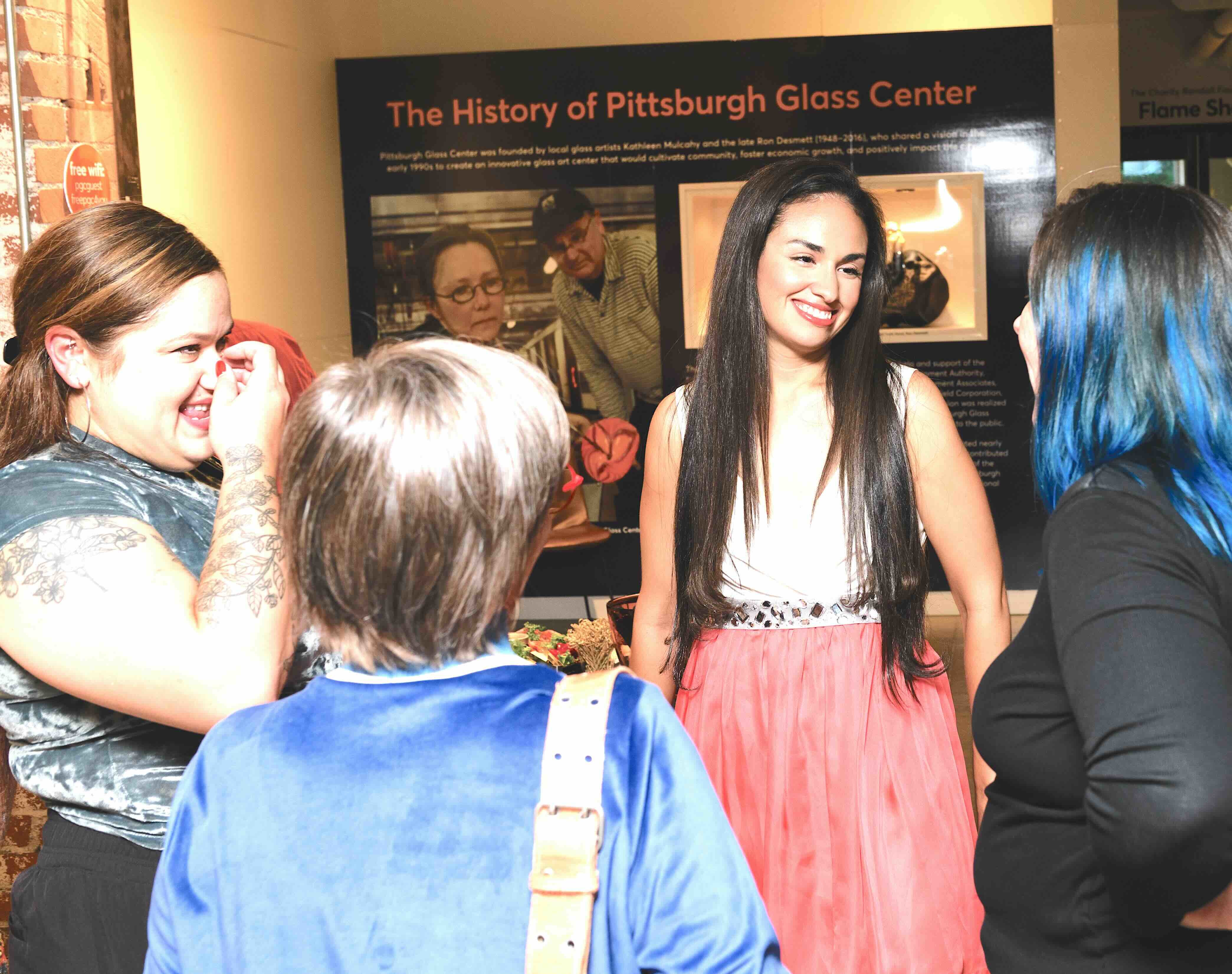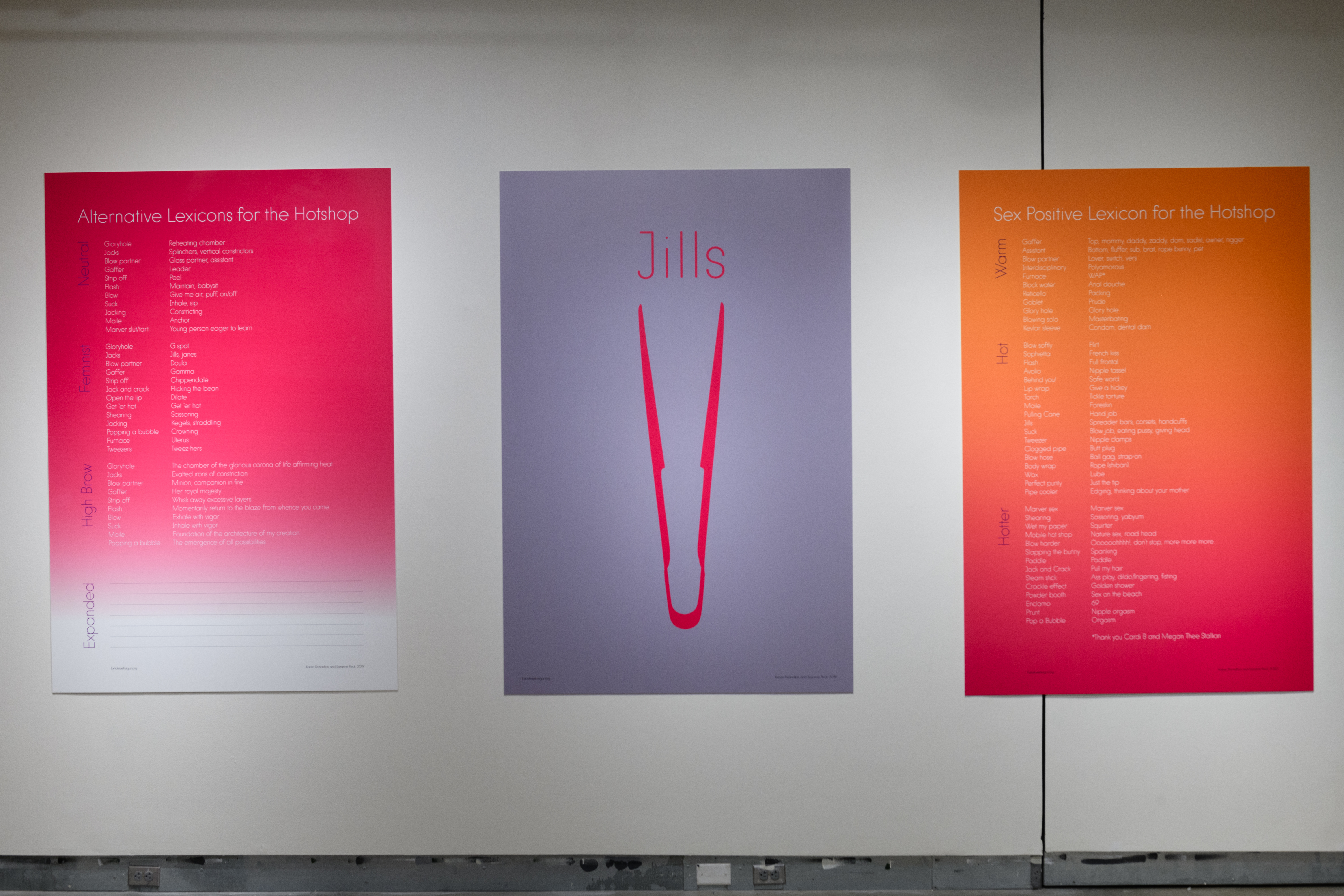Most of us are familiar, maybe even personally, with the term "glass ceiling." However, the concept of an invisible barrier in the workplace that prevents women and minorities from advancing professionally need not be simply accepted, however grudgingly. In fact, the metaphor can be recast, transformed from something that is scorned but widely accepted into something that becomes the change. The Pittsburgh Glass Center's new exhibition, Smash the ceiling, floor and walls; take the broken shards and blow it back, does exactly this, metaphorically speaking.
The exhibition is the creation of Carnegie Museum of Art assistant curator Alyssa Velazquez. With the rigid barriers of social injustices including misogyny and transphobia in mind, Alyssa set out to create a space where artists affected by those barriers could communicate their experiences. At PGC, she was able to locate a physical space as well as a diverse community of artists that used an array of different glass techniques to present their ideas of what change looks like. From Michelle Young Lee’s upheld neon rose to Dawn Bendick’s stack of multicolored glass rocks, each work provides a different take on the concept of creating a new life, literally picking up the pieces after a destruction. Velazquez calls it a "celebration of the self."
This is Velazquez's first foray into bridging the gap between museum projects at a major arts institutions and projects that involve less-established arts organizations. She acts as the assistant curator at the Carnegie Museum of Art, in addition to writing for a number of publications dedicated to uplifting women’s art and culture such as Women's History and GRLSQUASH. This exhibition is her presentation of the concept of destructive art. In a telephone interview with The Glass Quarterly Hot Sheet, Velazquez discussed the intent behind the broken glass, and how the resulting artworks put on display break social barriers and norms.

Glass: What drew you to the Pittsburgh Glass Center? Do you have anything else planned there?
Velazquez: I moved to Pittsburgh in 2019 and I took on a position at the Carnegie Museum of Art there. I was studying what made Pittsburgh Pittsburgh. I discovered that it was actually a place where you could make a living by making. There were so many scholarships and fellowships, and places just to try your hand at art. It’s very locally-centered, there’s a lot of local pride- people in Pittsburgh support each other.
People called it bottle caps and bow ties, all the different things being made. But between the bottle caps and bow ties were glass pieces. One of the artists, Margaret Spacapan, made a light fixture that is now part of the Carnegie collection. She had a residency at the Pittsburgh Glass Center. I went to do a studio visit, I met Heather McElwee, the executive director, and things happened. Things have changed there- there’s so much square footage now. I became a huge supporter of the Center and then through the exhibition work became part of the board.
It’s like UrbanGlass there--you don’t necessarily have to be an artist just yet. There are entry points to fall in love with the material.When the exhibition concludes, I will still be a board member, and will continue to advocate and expand the meaning of ‘glass ceiling’ beyond just women. It also very much includes the lived experiences of gender non-conforming people and other minorities. The Center actually features these demographics and caters certain opportunities to them. It felt like a natural fit for this exhibition to happen within this space.

Glass: How do you see your work at PGC vs. your work at the Carnegie Museum? Do you see yourself creating exhibitions like this one at Carnegie?
Velazquez: I think both the staff at the Pittsburgh Glass Center, and the glass making community, embrace improvisation. Glass artists develop problem solving skills and are quickly adaptable to change that can often happen in an instant. Compared to other experiences and spaces, those traits gave the exhibition process a lot of grace, allowing artists to change the dimensions of their artwork and the customization of installation fixtures based on the work in situ in the gallery.
Glass: And in this exhibition, what are some of the particular themes and experiences touched on by the artists?
Velazquez: All the artworks were made from lived experiences. And for me, that was really paramount for the exhibition. You have this metaphor, the glass ceiling, that was coined by Marilyn Loden in the 1970s for boundaries and restrictions specifically dealing with women’s economic advancement. And I thought, that’s one part of it, but there are so many other constraints- social, political, cultural- to be dealing with.They’re using glass to feed into a well of emotions, surrounding subjects like bodily autonomy, misogyny, reproductive rights, motherhood, self-expression, self-identity, violence, femicide, and even language. It’s about so many future possibilities, not necessarily about the present, but artists thinking about and signaling a future world or a future framework and point of view.
Glass: What difficulties have you encountered in glass art for femmes and GNC artists?
Velazquez: I asked the artists the same thing at the opening night of the exhibition. We had an artist talk there, and a lot of the artists were in attendance, we had Sandra Bacchi, Michelle Young Lee, Ann Weathersby. And part of the conversation that I initiated was this very question that you’re posing. Michelle said that she’d never been considered before as part of an exhibition of glass art. There are art spaces out there that can sometimes unknowingly replicate the systems of harm. And it was her first time ever being considered for something like this. She felt really validated by it. And she is a multidisciplinary artist; she hadn’t even known that she needed validation in glass until she finally got it.

Many of the artists present had their own stories about experiences with past exhibitions, and particularly about equitable pay; it’s not just about exposure anymore. And I think especially for gender non-conforming individuals, individuals who are minorities, those groups who are frequently at risk, may receive invitations sometimes that are couched in exposure but that don’t pay the bills. So it’s important to come up with a fee structure where the artist is adequately compensated.
What you don’t want is to feel that the opportunities within the art world are getting narrower. Some do feel that way because you can only do so much in a year. An artist might get one or two invitations, or they might get none or five. If they’re not being equitably paid it starts to add up and it becomes a burden. I think that if you have some identity that could be monopolized upon as the one within a space then there comes a kind of pressure on the artist to say yes or the opportunity won’t come again. And I’ve heard that from many an artist, to engage or not engage, and to evaluate the self-care one can provide oneself.
For that reason, the Center and I prioritize the care of our artists. If you’re asking an artist to enter a space and discuss one part of their identity, sometimes multiple parts of that will get cut off- and that’s not the institution’s fault necessarily- but it does happen. That’s why it’s good to get artist feedback. An artist who is a mother, for example, may be struggling to get to an artist talk, it won’t be accessible to them, if they don’t have childcare. It’s really important to go beyond and do more than what has been done.

Glass: Absolutely. Michelle Young Lee was the artist who created the neon artwork opening the exhibition, right?
Velazquez: Yes, she did. It symbolizes two things- the cases of femicide in Georgia, and the Asian hate that happened during the COVID lockdown. It’s called I am the signal, you are the wave. And I wanted it to be the signal. It oscillates between a hand holding a rose and a closed fist, and I wanted to communicate that the exhibition would be both. It would be a rallying cry but it would be beautiful.
Glass: How does glass art make you feel empowered to make change?
Velazquez: Well, early on, I came across an UrbanGlass community program called the Bead Project. I contacted the organizer at that program, and they put me in touch with some past participants. I fell in love with the work of Aullar Mateo, so I reached out to Aullar, and we talked. I started to think about beads in the exhibition but I worried about how to display them. Then I thought of Sandra Bacchi, who is a visual artist, and started out as a cinematographer who now explores glassmaking. She is a really gifted storyteller and I thought, I’ve never done this before, but what would it be like to put these two artists into dialogue with each other?
I wouldn’t say it was a commission, but it was an experimentation. Sandra was born in Brazil and now lives in Pittsburgh, and Aullar is based in New York- different ages, different locations, different points of life, but this was a way to cross paths and get in touch artistically. Aullar’s beads and Sandra’s ability to tell a story put together. If someone passes Aullar’s necklace and reads the label they might walk away with a slice of it, but they maybe haven’t grasped the full story, so the photography would provide that and take some of the pressure off the beads to do it all.
We created a performance piece. Sandra and I drove up to New York, we got a studio space. Much of the journey was the beads on skin, embracing skin, a kind of metamorphosis. We had a very opaque plastic material and had Aullar wrapped up in it, and there were a couple of hours of just pushing and pulling and grasping and breathing. And Sandra clicking her camera through it all. Eventually it became a triptych- in the exhibition, there’s a QR code next to it to view the whole photo shoot. I think my past background as a writer and theater-maker helped influence that process. It’s not fair to force one thing to speak to all aspects of an artist or a journey.
Sometimes I think it’s your community that helps reflect yourself back to you. But I don't think that’s out of the norm for glassmaking. It’s such a collaborative process, but there’s a generosity as well, that results in the object on the pedestal only having one name. There’s an understanding that behind the work of multiple hands there was a single idea, a primary concept. That generosity of spirit in glass, I think, is really beautiful.
There’s another piece in the exhibition, the Sexy Lexy posters by Karen Donnellan and Suzanne Peck, looking at terminology utilized in glassmaking and studying how to make it sexier and more inclusive. It works to break some binaries and handle glass in more loving and body-positive ways. I got to have those within the same space. It’s important to embrace the history of glass, but also to celebrate contemporary practices. It should prompt us on to the next iteration of glass, especially in this case for women, for femmes, what is it that we want the glass world to be? And what can we do as a collective to get there?
IF YOU GO:
Through January 20, 2025
"Smash the ceiling, floor and walls; take the broken shards and blow it back"
Pittsburgh Glass Center
5472 Penn Avenue,
Pittsburgh, Pennsylvania
Tel: 412-365-2145




